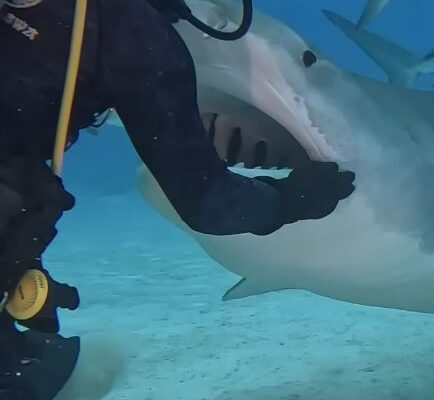The Desperate Gambit: A Tiger Shark’s Fight Against a Man-Made Menace
Sunlight dapples through the turquoise water, illuminating a scene of both majestic power and profound struggle. A tiger shark, a creature of ancient design and formidable presence, glides through its domain. But its fluid grace is marred by a ghastly punctuation mark: a large, cruel-looking fishing hook, embedded deep in the corner of its powerful jaw.
The image of a shark trying to dislodge a hook is a visceral and haunting one. It’s a moment that strips away the monster movie narrative and reveals a stark truth: this is an intelligent, capable animal in distress, fighting against an alien object it cannot comprehend. This single, dramatic encounter is a microcosm of a much larger, silent crisis unfolding beneath the waves.
The Apex and the Agony
The tiger shark (Galeocerdo cuvier) is one of the ocean’s most successful predators. Known as the “wastebasket of the sea” for its notoriously undiscerning palate, its jaw is a marvel of evolutionary engineering, capable of shearing through turtle shells, bone, and metal. It is a keystone species, vital for maintaining the health and balance of marine ecosystems by culling the weak and sick.
Yet, this incredible power is rendered agonizingly useless against a simple piece of sharpened steel. Observers and photographers who have witnessed this behavior describe it as calculated and deliberate. The shark doesn’t just thrash wildly. It may rub its jaw against rocks or the seafloor, or contort its body in a frustrating attempt to use its own pectoral fins to gain leverage. In some documented cases, sharks have been seen approaching dive boats or humans in the water, a behavior some interpret as a desperate, last-ditch effort to seek help—a chilling testament to their problem-solving intelligence colliding with their pain.
The Unseen Story of the Hook
Where does the hook come from? It’s the remnant of an interaction, a story that rarely has a happy ending. It’s a symbol of two major threats to marine life:
- Bycatch in Commercial Fishing: Industrial fishing operations, particularly those using longlines that can stretch for miles and carry thousands of baited hooks, are not selective. While they may be targeting tuna or swordfish, they inevitably attract and hook non-target species like sharks, sea turtles, dolphins, and seabirds. Many sharks that are hooked and released, like this one, are left with a permanent, debilitating injury. The hook can cause chronic pain, infection, and difficulty feeding, ultimately leading to a slow death from starvation.
- Ghost Gear: This hook could also be a piece of “ghost gear”—fishing equipment that has been lost, abandoned, or discarded. Lines, nets, and hooks drift through the ocean for decades, continuing to trap and kill marine life indiscriminately. A shark might have been drawn to old bait clinging to a lost line or simply snagged by the drifting hardware.
A Symbol of a Broader Conflict
The image of the tiger shark and the hook forces us to confront our relationship with the ocean. We often view these apex predators through a lens of fear, but this scene demands empathy. It reframes the shark not as a mindless menace, but as a victim of human activity. Its struggle is a powerful visual reminder of the unintended consequences of our actions, consequences that play out far from our sight.
This single shark represents countless others. From whales entangled in fishing ropes to sea turtles that have ingested plastic bags, the evidence of our impact is everywhere. The ocean is vast, but it is not invincible.
A Call for Change
While the plight of this one animal is heartbreaking, the story doesn’t have to end in despair. It can serve as a powerful catalyst for action. Awareness is the first step. Understanding the issues of bycatch and ghost gear is crucial for driving change. We can contribute by:
- Supporting Sustainable Seafood: Choosing seafood certified by organizations that promote responsible fishing practices helps reduce bycatch.
- Advocating for Policy Change: Supporting regulations that mandate biodegradable fishing gear, require better tracking of equipment, and create more marine protected areas.
- Supporting Conservation Organizations: Many groups are actively working to remove ghost gear from the ocean and rescue entangled animals.
The tiger shark, twisting in a desperate dance with a piece of metal, is sending a clear message. It is a portrait of resilience against overwhelming odds and an indictment of our carelessness. It’s a plea from the deep, asking us to be more mindful of the fragile world we share and the profound mark we leave upon it.
